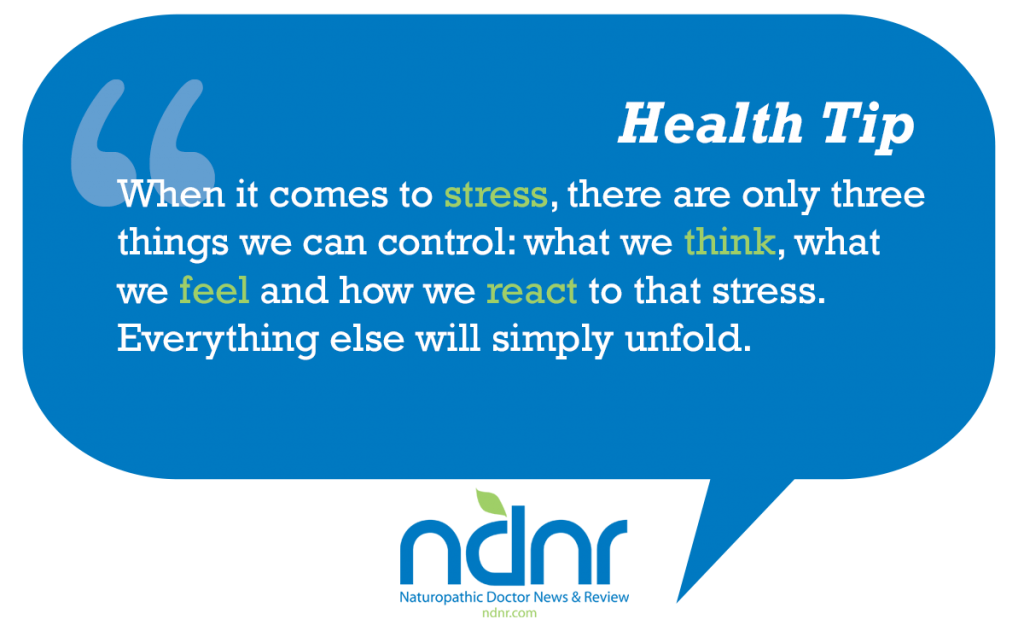Holistic Techniques for Stress Management and Chronic Disease
Laura A. James, ND
It is of paramount importance that we endorse stress management methods and give people the tools they need to prevent chronic disease
As NDs and allied integrative providers, we seek to attend to a patient’s physiological complaints, mental currency and spiritual longing. Body, mind and spirit are the fundamental components of who we are, and these components are invariably compromised with chronic disease. While stress has not yet been proven to cause disease, it has been linked to the exacerbation of various chronic illnesses. Stress is also a harbinger of ill health to come for those who are otherwise considered healthy.
In recent decades, the term “stress” has become clichéd as a descriptor of any mental or emotional burden, large or small. In fact, the term coined by Hans Selye was originally described as anything that applied “strain” on a person’s physical, emotional or spiritual state. This strain forces the body away from homeostasis. It could be acute or chronic, distressful or energizing, and directly threatening, constant or simply inconvenient.
Acute stress, comprised of less than a week-long duration, such as from the occurrence of an earthquake (Dimsdale, 2008), can precipitate acute physical events like myocardial infarction or emotional events like psychotic breakdown. Chronic stress, considered to be longer than the initial incident, will create strain over time and can ultimately have similar disastrous effects. Selye’s terms “distress” (bad stress) and “eustress” (good stress) are often based on the person’s perception of what is happening to them. Both can have similar effects on the body’s physiology. However, all of these forms of stress will affect the HPA axis (including cortisol output) and other body systems.
- Body: The physiological effects of stress have been outlined by this author in a previous edition of NDNR (May 2008), and this information is fundamental to our naturopathic education. Simply put, a dysregulation of cortisol and epinephrine can have ripple effects throughout all of the systems of the body – namely endocrine, neurological, cardiovascular, musculoskeletal and gastrointestinal systems.
- Mind: Stress will trigger anxiety, panic, self-criticism, self-doubt and a sense of overwhelm, and will mobilize both good and bad coping mechanisms. On the positive side, stress can spur motivation, clarity and purpose, and be thoroughly engaging and enjoyable, almost euphoric. The difference between a negative form of stress and a positive one is often due to one’s attitude about what is stressful.
- Spirit: Dissolution of spirit can be a dire outcome of stress, but often, stressful events encourage us to find meaning. Spiritual longing is borne out of challenge.
Stress Management Techniques
The best stress management techniques engage a person holistically. Tai Chi, yoga and meditation, for example, all have physical, emotional and spiritual components. Biofeedback works on the physiological level, but also engages the mind to recognize patterns and to attain control of them. Counseling in its many forms provides a forum for self-exploration and a witness to one’s story, both of which are powerful methods for creating shifts in attitude. Simple relaxing activities such as knitting can also provide an opportunity for meditation, deep relaxation and self-reflection. Just as we seek to treat each patient as an individual, different stress management techniques will resonate with different individuals. By understanding the characteristics and benefits of different techniques, we can more effectively present our patients with appropriate options.
The research presented here is recent. There appears to be an intense interest in studying stress and its physiological, emotional and spiritual outcomes. Modern science is evaluating various interventions using inadequate tools and reducing these complex interactions to linear models. Although many of these studies have inherent faults, they all share the philosophy that stress management intervention is highly beneficial.
Tai Chi
We all are familiar with the images of large groups of people of various ages practicing slow movements in parks in China or even in San Francisco’s Chinatown. Tai chi chuan is a slow-motion martial art from China that is most often practiced for better health. The term translates roughly as “supreme ultimate fist.” There are five original schools of tai chi chuan: Yang, Wu, Sun, Wu/Hao and Chen, and they are an expression of both Taoist and Confuscian philosophy. Tai chi is a form of “soft” martial art, one that is focused on internal power rather than external force. It is practiced for its meditative quality under the belief that focusing the mind on the slow movements will provide clarity and calm. Joints that move with relaxation rather than tension can respond more effectively, and the movements increase circulation of blood and lymph. Its health benefits are numerous, but tai chi remains a martial art, an activity designed for self-defense. By promoting a relaxed mind and body, this art can prepare a person to react appropriately to oncoming attack. Modern usage provides preparation for handling modern life’s stressors.
For patients with chronic heart failure (CHF), largely a deconditioned group of people older than age 60, tai chi can be an effective exercise and stress management tool. In a randomized, controlled trial, 30 patients with stable CHF and left ventricular ejection fraction = 40% were randomly assigned to receive “usual care” consisting of pharmacologic therapy and diet and exercise counseling, or 12 weeks of tai chi training in addition to usual care. Quality of life (QOL) was measured, as were exercise capacity and serum B-type natriuretic peptide and plasma catecholamine levels. After 12 weeks of twice-weekly tai chi sessions, patients in the tai chi group showed marked improvement of QOL scores, increased fitness and decreased serum B-type natriuretic peptide levels; a trend toward improvement in peak oxygen levels vs. controls was also observed. No differences in catecholamine levels were seen (Yeh et al., 2004). This trial demonstrates that tai chi could be an effective adjunctive treatment for CHF patients undergoing standard therapy.
Yoga
Yoga, a Sanskrit word meaning “to yoke,” is the ancient Hindu practice of asana (poses) accompanied by pranayama (breathing practice), meditation and spiritual inquiry. It was developed as a method to control the mind’s wanderings. We are most familiar with the asana practice, which is inseparable from the additional aspects of yoga. Modern yoga has its roots in Patañjali’s yoga sutras, and is an eight-limbed path (Roach and McNally, 2005). Many of these eight steps focus on changing mental attitudes and on living in the world with gratitude and service. Yoga was introduced in the U.S. in the mid-20th century and is one of the fastest-growing forms of exercise and spiritual conversation. Today, Americans are the innovators and trend setters in the field of yoga and have created many forms for people to choose from, many of which have descended from Hatha yoga (Anusara, Iyengar, Vinyasa, Ashtanga, etc). There are many other forms from the Hindu tradition, and many from other religious disciplines such as Buddhism.
Pullen et al. (2008) recently showed that an 8-week regimen of yoga with a focus on asana practice and breathing exercise improved exercise tolerance, inflammatory markers and QOL in 19 patients with stable CHF. There were statistically significant reductions in serum levels of high-sensitivity C-reactive protein (hsCRP) and IL-6, and an increase in extracellular superoxide dismutase (EC-SOD) in the yoga treatment group. Added to standard medical therapy, this method showed that patients with CHF could experience benefit on physical, neurological, mental and emotional levels.
Meditation
Several forms of meditation have captured the Western imagination: these include Jon Kabat-Zinn’s Mindfulness-Based Stress Reduction (MBSR) program; Eknath Easwaran’s Eight-Point Program (EPP) that includes “passage meditation” and has its roots in a yogic tradition; Transcendental Meditation that Maharishi Mahesh Yogi popularized through The Beatles; and Herbert Benson’s style of meditation that elicits the “relaxation response.” MBSR and the EPP are highlighted here.
Kabat-Zinn, PhD, popularized mindfulness meditation through several books, and has created a reproducible system for teaching mindfulness to patients in the outpatient setting (1990). This type of meditation has three basic tenets: intention, attention and attitude. The premise is to intentionally attend to one’s moment-to-moment experience in a nonjudgmental and accepting way. Using a breath posture in sitting meditation, thoughts will arise that can be carefully examined but not judged by the attentive mind. A body scan can alert the practitioner to sensations throughout the body, which again are regarded without criticism. Mindful movement increases awareness of the body and its relationship to the natural world. Breathing space focuses on breath work, such as deep abdominal breathing, and loving kindness meditation helps the practitioner develop feelings of compassion. MBSR is traditionally taught over an 8-week period, with 2.5-hour sessions
each week. MBSR has been proven to dramatically reduce perceptions of stress and medical complaints while increasing feelings of hope, greater connectedness with community and overall well-being. Additionally, those who practice MBSR report an increased sense of spiritual connectedness. With 82% of Americans expressing spiritual longing, meditation may be one way for people to develop that connection (Thoresen and Harris, 2008).
Easwaran’s EPP is focused on passage meditation: the idea that with mentally repeating a positive, practical, inspiring and universal passage from any religious tradition, peace comes to the heart and mind (2008). It is recommended that passage meditation be conducted daily for 30 minutes. Complementary to passage meditation are the other seven points:
- The mantram: repeating a word or phrase that connotes peace and compassion
- Slowing down: refraining from a sense of time urgency
- Focused attention: only doing one thing at a time and devoting one’s entire attention to that task
- Training the senses: acclimating to the one-thing-at-a-time philosophy
- Putting others first: engaging in service to an individual or group
- Spiritual fellowship: finding a spiritual home for discussion and ritual
- Inspirational reading: participating in lifelong learning as appropriate
These steps can be completed daily as well, but are less formalized than sitting passage meditation.
At the University of Santa Clara, Shapiro and Oman have been looking at meditation and stress in a student population. While studentship is not a chronic disease, high stress in this population is linked to anxiety, depression, suicidal ideation, hopelessness, poor health behaviors, headaches, sleep disturbances, increased rates of athletic injury and the common cold (Oman and Shapiro, 2008). The authors looked at measures of forgiveness, perceived stress and rumination using MBSR or EPP as the modality. They found that mindful movement marginally predicted forgiveness, but reductions in perceived stress and rumination were significant. Increased levels of mindful attention and awareness were clearly demonstrated. There were no adverse effects from training. There is, however, a lack of a multidimensional measure that captures the meaning of mindfulness (Shapiro and Oman, 2008).
In another study, women with fibromyalgia and depressive symptoms enrolled in a randomized clinical trial and either learned to practice MBSR in an 8-week program or were simply evaluated. Those who engaged in MBSR had significantly improved perceptions of their depression and pain, thus reducing the impact of those complaints. Two months later, the results were even more pronounced. It is surmised that through MBSR, patients with fibromyalgia and depression can alter their worldview so that life is perceived as more manageable and meaningful (Sephton, 2007).
Finally, a Loyola University group looked at the effect and feasibility of an MBSR program on immune function, QOL and coping in women recently diagnosed with breast cancer. Early-stage patients who did not receive chemotherapy were self-selected into an 8-week MBSR program or assessment-only control group. Outcomes were evaluated over time. The first assessment was at least 10 days after surgery and prior to adjuvant therapy, as well as before the MBSR start-up. Further assessments were mid-MBSR at completion of MBSR and at 4-week post-MBSR completion. Pre-MBSR training, women showed reductions in NK cell activity and IFN-. production with increases in IL-4, IL-6 and IL-10 production and plasma cortisol levels. This was observed for both the MBSR and non-MBSR groups of breast cancer patients. Over time, women in the MBSR group reestablished their immune function, but women in the control group did not. MBSR participants also showed marked reduction in cortisol levels, and improved QOL and coping effectiveness compared to the non-MBSR group (Witek-Janusek, 2008).
Westerners, particularly Americans, are compelled to live in a state of overdrive. We over-schedule ourselves and our families, passively ingest a constant stream of information, hype ourselves on coffee and other stimulants, and then think that we can continue running at this speed without consequence. We may even think it’s “tough” and “cool” to be this way. Today’s professional women are expected to manage both career and family, complete most of the housework, and still host and attend social gatherings. Men are often saddled with being the primary breadwinner and being active and present fathers even when their job makes the latter a difficult proposition. Add the global strain of an economic downturn, and even small hassles become major problems.
Our culture trends are leading us away from stress-reducing activities and towards stress-inducing ones. As natural health providers, it is of paramount importance that we endorse stress management methods and give people the tools they need to prevent chronic disease. And, we need to remind patients that when it comes to stress, there are only three things we can control: what we think, what we feel and how we react to that stress. Everything else will simply unfold. The Oncology Association of Naturopathic
Physicians (OncANP) was founded in 2004 to enhance the quality of life of people living with cancer through both increasing the collaboration between NDs working with patients with cancer and integrating naturopathic practice into medical oncology care. With its co-organization, the American Board of Naturopathic Oncology (ABNO), the OncANP has set standards, instituted testing and now credentials Fellows in Naturopathic Oncology. The OncANP welcomes all NDs interested in improving their knowledge and ability to work with oncology patients. For more information visit www.OncANP.org.
 Laura A. James, ND is a graduate of Tufts University, as well as Bastyr University’s naturopathic medicine program. She practices complementary care for cancer patients in both Bellevue and Bellingham, Wash. She counsels patients on whole foods nutrition, botanical medicine, nutritional supplements and lifestyle modifications to attain optimum mind/body balance as they go through cancer treatment and into survivorship. Dr. James is trained in safely managing CAM therapies with conventional medicine and is a member of the Oncology Association of Naturopathic Physicians. She is also trained in biofeedback modalities for stress management and chronic symptom control.
Laura A. James, ND is a graduate of Tufts University, as well as Bastyr University’s naturopathic medicine program. She practices complementary care for cancer patients in both Bellevue and Bellingham, Wash. She counsels patients on whole foods nutrition, botanical medicine, nutritional supplements and lifestyle modifications to attain optimum mind/body balance as they go through cancer treatment and into survivorship. Dr. James is trained in safely managing CAM therapies with conventional medicine and is a member of the Oncology Association of Naturopathic Physicians. She is also trained in biofeedback modalities for stress management and chronic symptom control.
References
Dimsdale JE: Psychological stress and cardiovascular disease, J Am Coll Cardiol 51(13):1237-46, 2008.
Easwaran E: Passage Meditation: Bringing the Deep Wisdom of the Heart into Daily Life (3rd ed). Berkeley, 2008, Nilgiri Press.
James L: Stress management interventions and breast cancer, Naturopathic Doctor News & Review 4(5):1-6, 2008.
Kabat-Zinn J: Full Catastrophe Living: Using the Wisdom of Your Body and Mind to Face Stress, Pain, and Illness. New York, 1990, Doubleday.
Oman D, Shapiro S: Meditation lowers stress and supports forgiveness among college students: a randomized controlled trial, J Am Coll Health 56(5); 569-78, 2008.
Pullen PR: Effects of yoga on inflammation and exercise capacity in patients with chronic heart failure, J Card Fail 14(5):407-13, 2008.
Roach GM, McNally LC: The Essential Yoga Sutra: Ancient Wisdom for Your Yoga. New York, 2005, Three Leaves Press.
Sephton S: Mindfulness meditation alleviates depressive symptoms in women with fibromyalgia: results of a randomized clinical trial, Arthritis Rheum 57(1):77-85, 2007.
Shapiro S, Oman D: Cultivating mindfulness: Effects on wellbeing, J Clin Psychol 64(7):840-62, 2008.
Thoresen CE, Harris AH: Spirituality and health: what’s the evidence and what’s needed. In Carmody J et al., Mindfulness, spirituality, and health-related symptoms, J Psychosom Res 64(4):393-403, 2008.
Witek-Janusek L: Effect of mindfulness based stress reduction on immune function, quality of life and coping in women newly diagnosed with early stage breast cancer, Brain Behav Immun 22(6):969-81, 2008.
Yeh GY et al: Effects of tai chi mind-body movement therapy on functional status and exercise capacity in patients with chronic heart failure: A randomized controlled trial, Am J Med 117(8):541-8, 2004.








